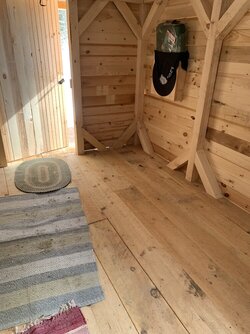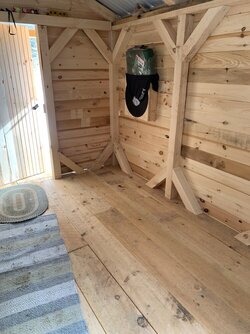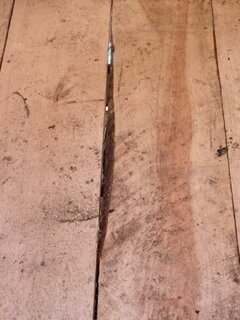Suggestions for heating small 200 sq uninsulated cabin
- Thread starter obrienmzt2
- Start date
-
Active since 1995, Hearth.com is THE place on the internet for free information and advice about wood stoves, pellet stoves and other energy saving equipment.
We strive to provide opinions, articles, discussions and history related to Hearth Products and in a more general sense, energy issues.
We promote the EFFICIENT, RESPONSIBLE, CLEAN and SAFE use of all fuels, whether renewable or fossil.
You are using an out of date browser. It may not display this or other websites correctly.
You should upgrade or use an alternative browser.
You should upgrade or use an alternative browser.
Any caulk or silicone can fix the cracks. You may need to use a backer on some of the wider gaps. Some sealants can not be painted afterwords, so you may want to be careful with the choice.
The hardest part of heating small areas is achieving an even heat. Once you heat the space up, a wood stove doesn’t shut off. It has to continue pumping out heat until all of the fuel is used.
The 2nd hardest part of heating small spaces is the loss of floor space. Wood stoves need open space between the stove and combustible materials like walls. With so little floor space available, setting aside the square footage for the stove might not be acceptable.
For these reasons, I’d look into wall mounted vented propane or electric heat.
The hardest part of heating small areas is achieving an even heat. Once you heat the space up, a wood stove doesn’t shut off. It has to continue pumping out heat until all of the fuel is used.
The 2nd hardest part of heating small spaces is the loss of floor space. Wood stoves need open space between the stove and combustible materials like walls. With so little floor space available, setting aside the square footage for the stove might not be acceptable.
For these reasons, I’d look into wall mounted vented propane or electric heat.
I really appreciate the response! I added a few pictures of where the cabin designer put the woodstove thimble. My wife is really hoping we can use a woodstove. Any idea if this is enough room?Any caulk or silicone can fix the cracks. You may need to use a backer on some of the wider gaps. Some sealants can not be painted afterwords, so you may want to be careful with the choice.
The hardest part of heating small areas is achieving an even heat. Once you heat the space up, a wood stove doesn’t shut off. It has to continue pumping out heat until all of the fuel is used.
The 2nd hardest part of heating small spaces is the loss of floor space. Wood stoves need open space between the stove and combustible materials like walls. With so little floor space available, setting aside the square footage for the stove might not be acceptable.
For these reasons, I’d look into wall mounted vented propane or electric heat.


That's some overkill construction for a small place and it looks like it was done with green wood. I see leaks all around the base perimeter. This will get worse as the wood dries, unfortunately. It may take putting a wrap on the exterior and siding to seal the place. Insulation could be done on the exterior too that would help seal the place if done right.
This is a very small space to heat with wood. It might be easier to heat with a different fuel than wood. Clearances will depend on the stove requirements.
There are many threads here on heating a small space. Click on the Search icon at the upper left and search on "Tiny House", in titles only, in this forum. You'll find a lot of information on small stoves and alternative considerations.
This is a very small space to heat with wood. It might be easier to heat with a different fuel than wood. Clearances will depend on the stove requirements.
There are many threads here on heating a small space. Click on the Search icon at the upper left and search on "Tiny House", in titles only, in this forum. You'll find a lot of information on small stoves and alternative considerations.
LogCabinFever
Member
Either a clear or paintable caulk. You can use wood epoxy on the bigger stuff, then just stain/paint it afterwards if you wanted.
For heating that space, it depends on what type of heat you want. If it’s wood, look into a company called tinywoodstove.com. There are other manufacturers too of “tiny wood stoves”.
For heating that space, it depends on what type of heat you want. If it’s wood, look into a company called tinywoodstove.com. There are other manufacturers too of “tiny wood stoves”.
Only you (or your wife, lol) can decide if there’s enough room. If you find a stove you like, a piece of cardboard cut to stove size laid out on the floor so you can measure out any needed clearances can help you decide if there’s enough room. Remember to leave the required room in front of the stove! Some stoves only need ember floor protection, so a piece of sheet metal can often satisfy this. The sheet metal can be walked over.
You may have trouble with an uninsulated, ribbed metal roof. That would make any heating job difficult.
You may have trouble with an uninsulated, ribbed metal roof. That would make any heating job difficult.
Are you planning on using this 3 seasons. It can work. Thats how many summer cabins are built if there is no winter heat. The wood drys out. If it's winter use I would insulate under the siding with the best R value foam. Next I would insulate interior ceiling. Although the space is small, being open will allow more even heating. It's always hard to say how much stove is needed to heat a house, no insulation will definitely make it as hard as it gets.
You also could use traditional Oakum pounded in the cracks. It is used for traditional wooden boats
Rob_Red
Feeling the Heat
We want to eventually be able to sleep in it. This is not meant to be a primary residence, just a spot to sleep for a day or two here and there. Just wondering if it is possible/smart to have a woodstove in it with insulating it.What is the purpose of this building? Do you plan to camp in it?
We would like to be able to sleep in it in winter at some point. We have from now until the next winter to make it appropriate for winter sleeping.Are you planning on using this 3 seasons. It can work. Thats how many summer cabins are built if there is no winter heat. The wood drys out. If it's winter use I would insulate under the siding with the best R value foam. Next I would insulate interior ceiling. Although the space is small, being open will allow more even heating. It's always hard to say how much stove is needed to heat a house, no insulation will definitely make it as hard as it gets
stoveliker
Minister of Fire
In Vermont, you'll need sealing and insulation to make it appropriate for (sleeping) in winter. No way around that.
Do that (including the floor so your toes don't freeze off..), and then get a stove.
Do that (including the floor so your toes don't freeze off..), and then get a stove.
sneefy
Burning Hunk
A Cubic Mini wood stove that hangs on the wall would be a good solution.
I see daylight coming from the steel ribs on the roof. I agree with sealing that cabin up. Looks super leaky at present. Bare steel on the roof with open purlins is about the lowest r-value you can get. It will also have condensation problems and it would also be loud in the rain. I'd close the ends of the steel with foam closure strips, spray foam the ceiling at least 2" deep and hang tongue/groove pine. All that assumes the roof is rated for the weight...
I see daylight coming from the steel ribs on the roof. I agree with sealing that cabin up. Looks super leaky at present. Bare steel on the roof with open purlins is about the lowest r-value you can get. It will also have condensation problems and it would also be loud in the rain. I'd close the ends of the steel with foam closure strips, spray foam the ceiling at least 2" deep and hang tongue/groove pine. All that assumes the roof is rated for the weight...
Last edited:
Rob_Red
Feeling the Heat
The ribbed tin roof with act like a heat sink and will actually transfer your heat into the outside air pretty efficiently.
Also a tiny stove won’t burn for very long so you will be waking up to a un heated space. It will be pretty difficult to maintain the “cozy cabin” feel.
I’ve lived on a boat with a micro wood stove in winter and you never are warm like in a house
If it were me I would get some good sleeping bags
Also a tiny stove won’t burn for very long so you will be waking up to a un heated space. It will be pretty difficult to maintain the “cozy cabin” feel.
I’ve lived on a boat with a micro wood stove in winter and you never are warm like in a house
If it were me I would get some good sleeping bags
Appreciate the info! So, do you reckon we could get away without insulating the ceiling?The ribbed tin roof with act like a heat sink and will actually transfer your heat into the outside air pretty efficiently.
Also a tiny stove won’t burn for very long so you will be waking up to a un heated space. It will be pretty difficult to maintain the “cozy cabin” feel.
I’ve lived on a boat with a micro wood stove in winter and you never are warm like in a house
If it were me I would get some good sleeping bags
stoveliker
Minister of Fire
Appreciate the info! So, do you reckon we could get away without insulating the ceiling?
But then why not camp in a tent?
I would not. With a small stove and some (not perfect) insulation you may still need your sleeping bags to stay warm at the end of the night. (And a big stove with sufficient burn time to avoid that would be too large physically..)
We definitely plan on using sleeping bags, but we aren't sure what is essential and what we can get away with regarding insulating.But then why not camp in a tent?
I would not. With a small stove and some (not perfect) insulation you may still need your sleeping bags to stay warm at the end of the night. (And a big stove with sufficient burn time to avoid that would be too large physically..)
Unfortunately, whoever built this was not thinking about sealing. In the least, the siding boards should have been shiplapped or placed vertically with battens to accommodate shrinkage as the wood dries. Not only are wind and rain going to blow and leak through this structure, but every bug and spider will eventually find their way through the gaps, especially in fall when they seek shelter for the winter. The cheapest thing to do may be to wrap the exterior in tar paper or Tyvek. That will get you through the winter and you can then put on some siding over the wrap. Tar paper could also be stapled under the floor between the joists if there is crawlspace room. The metal roof should be sealed at the top sill plate. Spray foam might work there. Then, a small stove will take the edge off of winter. There are several mentioned in the tiny home threads. Were you able to find them using the Search?
Stoves by Cubic, Mariner will work, so will a small Jotul, Morso, etc., as long as clearances are honored and a proper hearth installed. Room temp will swing quite a bit and getting up once or twice at night to stoke the fire when it's cold out will be normal.
Stoves by Cubic, Mariner will work, so will a small Jotul, Morso, etc., as long as clearances are honored and a proper hearth installed. Room temp will swing quite a bit and getting up once or twice at night to stoke the fire when it's cold out will be normal.
sneefy
Burning Hunk
If you seal it and insulate it well, you could sleep comfortably in whatever you wish using just a modest stove.We definitely plan on using sleeping bags, but we aren't sure what is essential and what we can get away with regarding insulating.
If it were me, I'd want to be comfortable in a cabin and not fight the cold. That's kinda the point. I stayed in an insulated yurt in the middle of winter and the stove kept it nice and toasty. It was quite pleasant. Insulation is critical.
From what I see it looks to be a unheated shed construction. Watch, Main Cabin Builders. They have loads of those, summer cabins. Because they don't get used much they get torn up by moisture, bugs and animals. If your thinking of a first heat source, wood stove heat is great. It will dry the place out out. Assuming you are up to the work of getting wood. It's going to use a lot of wood and hard to get the place hot with wind blowing through the walls and floor. At the very least figure out how to seal up all the gaps.
Winterizing the place will be a challenge, that needs to be carefully figured out. Insulation and no heat can cause big moisture problems. That's why unheated summer cabins have no insulation. But it can be done. just plan on providing year round minimum heat.
Winterizing the place will be a challenge, that needs to be carefully figured out. Insulation and no heat can cause big moisture problems. That's why unheated summer cabins have no insulation. But it can be done. just plan on providing year round minimum heat.
A winter without insulation will quickly tell you what you want to /need to change!We definitely plan on using sleeping bags, but we aren't sure what is essential and what we can get away with regarding insulating.
I love that wood look to a cabin and you could seal up the holes with some wood stuff--whatever is the best and if it were me I would wrap the whole outside with some kind of insulation--unless it is a log cabin or something like that--do not know...But I would definitely insulate it. I without knowledge here think that it is too small of a space for a wood stove and would inquire about heating it another way...Your going to enjoy your woodsy cabin if you make it comfortable and it is a second home as well--I would go the whole way--by insulating and one very cold night with the family would give it a whole new thrust and so not convenient., especially us women who thrive on warm temperatures and do it for her too and stop being a he man who wants to rough it. The last thing I would want in a place of peace is to wake up in a sleeping bag..--not at my age..clancey
Similar threads
- Replies
- 11
- Views
- 601
- Replies
- 22
- Views
- 1K
- Replies
- 13
- Views
- 1K
- Replies
- 6
- Views
- 533


